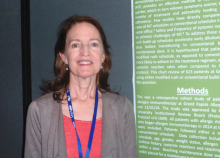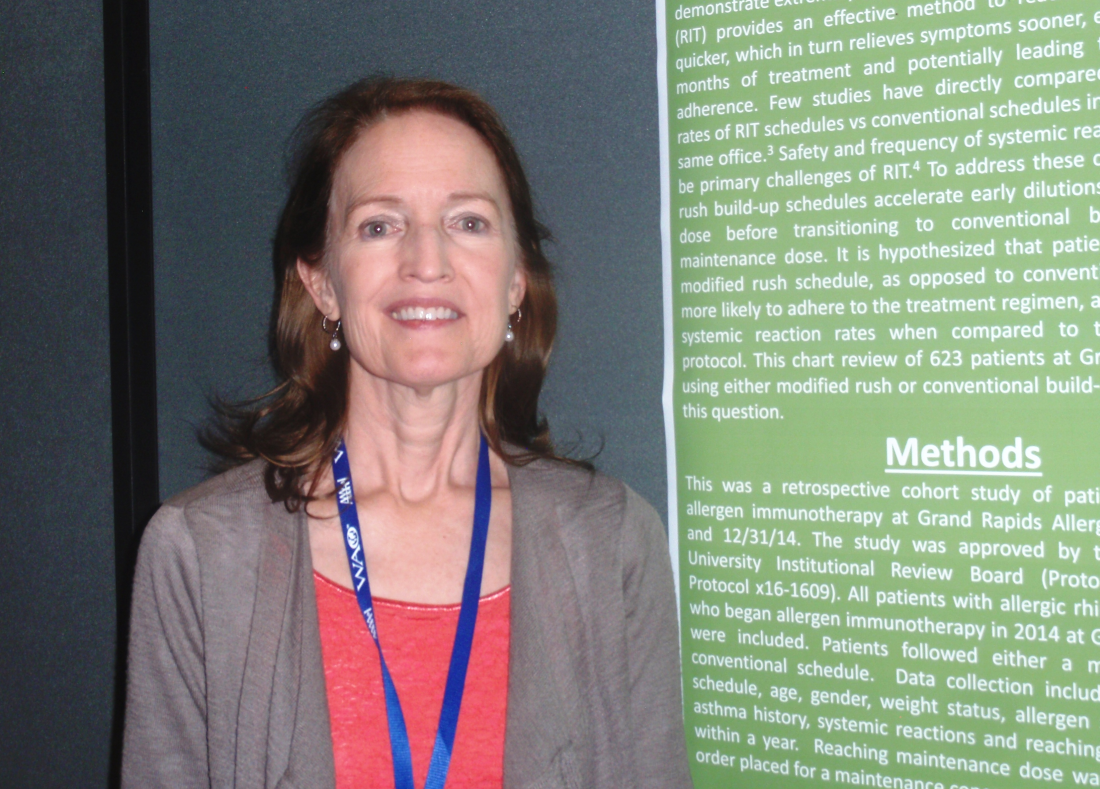User login
ORLANDO – Patients with allergic rhinitis undergoing allergen immunotherapy achieved the goal of their monthly maintenance dose at a 20% higher rate when they underwent went a “modified rush” protocol, compared with those who received the therapy with the much slower conventional approach.
The findings offer proof that the faster approach is safe, more effective, and should be more widely used even though many allergists continue to be hesitant to do so, according to Christine Schafer, MD, clinical assistant professor at Michigan State University, East Lansing and a private practice allergist in Grand Rapids, Mich.
“The beauty of it is you’ve consolidated 3 months into a day,” said Dr. Schafer, who added that patients also feel better faster. “They don’t have to have this going every week for 3 months not feeling any better.”
Dr. Schafer and her colleagues reviewed a year’s worth of results for patients undergoing conventional immunotherapy or a “modified rush” protocol in 2014. They found that the conventional approach produced a 64.5% success rate, compared with an 84.4% success rate for those doing the faster protocol (P less than .001).
Typically, allergen immunotherapy takes 6 months, with patients making weekly visits with gradually increasing doses. The weekly visits can be a burden, and many patients drop out. The modified rush protocol seems to be easier for patients to accomplish, Dr. Schafer said at the joint congress of the American Academy of Allergy, Asthma, and Immunology and the World Asthma Organization.
The study compared 231 patients on the faster protocol with 392 treated with the traditional approach.
On the “modified rush” protocol, patients aged 12-15 years took preventive medications – 20 mg of prednisone and 150 mg of ranitidine 2 days before their appointment and again the day after. In addition, they took 10 mg of cetirizine and 5 mg of montelukast 2 days before their appointment. Patients also took those same medications the morning of the treatment.
For patients 16 and older, the dose of prednisone was 30 mg and the dose of montelukast was 10 mg.
The protocol consisted of eight shots, starting at a more diluted dose than the conventional protocol, as an additional safety precaution. The shots were given first every 15 minutes, then every 30 minutes or an hour as the dose increases. Once the treatment was over, the dilution was 1:10, a milestone not reached until 3 months under the conventional approach.
An hour or two after the treatment, all patients received 20 mg of prednisone.
Patients resumed the normal conventional protocol after the first visit.
Reactions were rare under the “modified rush” protocol, with 6 patients experiencing flushing but nothing else, 21 with grade 1 reactions, 3 with grade 2, and no reactions worse than that. Five patients needed epinephrine.
Dr. Schafer said the approach may hold appeal because, even though it’s accelerated, there is a slower lead-in to the maintenance dose.
“If you ask allergists, ‘Do you rush?’ they’ll say, ‘No, no, no, I don’t rush. It’s too risky.’” she said. “Hence, modified rush.”
SOURCE: Schafer C et al. AAAAI/WAO Joint Congress abstract 520.
ORLANDO – Patients with allergic rhinitis undergoing allergen immunotherapy achieved the goal of their monthly maintenance dose at a 20% higher rate when they underwent went a “modified rush” protocol, compared with those who received the therapy with the much slower conventional approach.
The findings offer proof that the faster approach is safe, more effective, and should be more widely used even though many allergists continue to be hesitant to do so, according to Christine Schafer, MD, clinical assistant professor at Michigan State University, East Lansing and a private practice allergist in Grand Rapids, Mich.
“The beauty of it is you’ve consolidated 3 months into a day,” said Dr. Schafer, who added that patients also feel better faster. “They don’t have to have this going every week for 3 months not feeling any better.”
Dr. Schafer and her colleagues reviewed a year’s worth of results for patients undergoing conventional immunotherapy or a “modified rush” protocol in 2014. They found that the conventional approach produced a 64.5% success rate, compared with an 84.4% success rate for those doing the faster protocol (P less than .001).
Typically, allergen immunotherapy takes 6 months, with patients making weekly visits with gradually increasing doses. The weekly visits can be a burden, and many patients drop out. The modified rush protocol seems to be easier for patients to accomplish, Dr. Schafer said at the joint congress of the American Academy of Allergy, Asthma, and Immunology and the World Asthma Organization.
The study compared 231 patients on the faster protocol with 392 treated with the traditional approach.
On the “modified rush” protocol, patients aged 12-15 years took preventive medications – 20 mg of prednisone and 150 mg of ranitidine 2 days before their appointment and again the day after. In addition, they took 10 mg of cetirizine and 5 mg of montelukast 2 days before their appointment. Patients also took those same medications the morning of the treatment.
For patients 16 and older, the dose of prednisone was 30 mg and the dose of montelukast was 10 mg.
The protocol consisted of eight shots, starting at a more diluted dose than the conventional protocol, as an additional safety precaution. The shots were given first every 15 minutes, then every 30 minutes or an hour as the dose increases. Once the treatment was over, the dilution was 1:10, a milestone not reached until 3 months under the conventional approach.
An hour or two after the treatment, all patients received 20 mg of prednisone.
Patients resumed the normal conventional protocol after the first visit.
Reactions were rare under the “modified rush” protocol, with 6 patients experiencing flushing but nothing else, 21 with grade 1 reactions, 3 with grade 2, and no reactions worse than that. Five patients needed epinephrine.
Dr. Schafer said the approach may hold appeal because, even though it’s accelerated, there is a slower lead-in to the maintenance dose.
“If you ask allergists, ‘Do you rush?’ they’ll say, ‘No, no, no, I don’t rush. It’s too risky.’” she said. “Hence, modified rush.”
SOURCE: Schafer C et al. AAAAI/WAO Joint Congress abstract 520.
ORLANDO – Patients with allergic rhinitis undergoing allergen immunotherapy achieved the goal of their monthly maintenance dose at a 20% higher rate when they underwent went a “modified rush” protocol, compared with those who received the therapy with the much slower conventional approach.
The findings offer proof that the faster approach is safe, more effective, and should be more widely used even though many allergists continue to be hesitant to do so, according to Christine Schafer, MD, clinical assistant professor at Michigan State University, East Lansing and a private practice allergist in Grand Rapids, Mich.
“The beauty of it is you’ve consolidated 3 months into a day,” said Dr. Schafer, who added that patients also feel better faster. “They don’t have to have this going every week for 3 months not feeling any better.”
Dr. Schafer and her colleagues reviewed a year’s worth of results for patients undergoing conventional immunotherapy or a “modified rush” protocol in 2014. They found that the conventional approach produced a 64.5% success rate, compared with an 84.4% success rate for those doing the faster protocol (P less than .001).
Typically, allergen immunotherapy takes 6 months, with patients making weekly visits with gradually increasing doses. The weekly visits can be a burden, and many patients drop out. The modified rush protocol seems to be easier for patients to accomplish, Dr. Schafer said at the joint congress of the American Academy of Allergy, Asthma, and Immunology and the World Asthma Organization.
The study compared 231 patients on the faster protocol with 392 treated with the traditional approach.
On the “modified rush” protocol, patients aged 12-15 years took preventive medications – 20 mg of prednisone and 150 mg of ranitidine 2 days before their appointment and again the day after. In addition, they took 10 mg of cetirizine and 5 mg of montelukast 2 days before their appointment. Patients also took those same medications the morning of the treatment.
For patients 16 and older, the dose of prednisone was 30 mg and the dose of montelukast was 10 mg.
The protocol consisted of eight shots, starting at a more diluted dose than the conventional protocol, as an additional safety precaution. The shots were given first every 15 minutes, then every 30 minutes or an hour as the dose increases. Once the treatment was over, the dilution was 1:10, a milestone not reached until 3 months under the conventional approach.
An hour or two after the treatment, all patients received 20 mg of prednisone.
Patients resumed the normal conventional protocol after the first visit.
Reactions were rare under the “modified rush” protocol, with 6 patients experiencing flushing but nothing else, 21 with grade 1 reactions, 3 with grade 2, and no reactions worse than that. Five patients needed epinephrine.
Dr. Schafer said the approach may hold appeal because, even though it’s accelerated, there is a slower lead-in to the maintenance dose.
“If you ask allergists, ‘Do you rush?’ they’ll say, ‘No, no, no, I don’t rush. It’s too risky.’” she said. “Hence, modified rush.”
SOURCE: Schafer C et al. AAAAI/WAO Joint Congress abstract 520.
REPORTING FROM AAAAI/WAO JOINT CONGRESS
Key clinical point: Completing an immunotherapy regimen on a ‘modified rush’ basis leads to better adherence.
Major finding: A total of 84.4% completed the ‘modified rush’ protocol, vs. 65.4% for the conventional protocol.
Study details: Retrospective chart review of 623 patients who received allergen immunotherapy via the conventional, 6-month approach or a modified, faster approach.
Disclosures: The investigators reported no conflicts of interest.
Source: Schafer C et al. AAAAI/WAO Joint Congress abstract 520.

